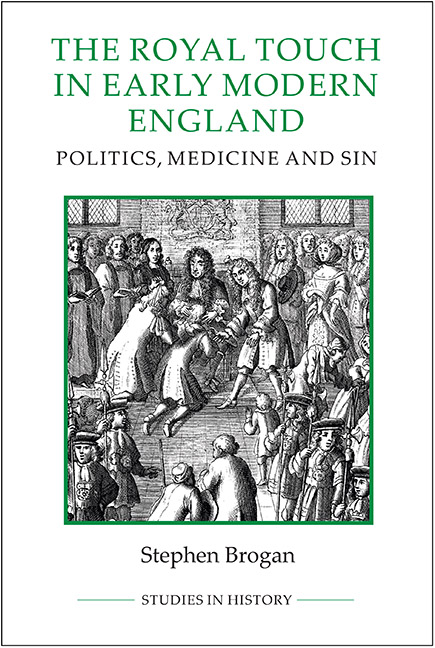Book contents
- Frontmatter
- Contents
- List of Illustrations
- List of Tables
- Dedication
- Acknowledgements
- Abbreviations
- Introduction
- 1 The origins and medieval history of the royal touch, 1000–1485
- 2 The Tudors: revival and reform of royal therapeutics, 1485–1603
- 3 The royal touch and the Stuart monarchy, 1603–1688
- 4 The ritual process of the royal touch, 1660–1688
- 5 The Restoration debate: the rise of ambivalence and scepticism, 1660–1688
- 6 The royal touch and the early English Enlightenment, 1689–1750
- Conclusion
- Bibliography
- Index
4 - The ritual process of the royal touch, 1660–1688
Published online by Cambridge University Press: 17 June 2021
- Frontmatter
- Contents
- List of Illustrations
- List of Tables
- Dedication
- Acknowledgements
- Abbreviations
- Introduction
- 1 The origins and medieval history of the royal touch, 1000–1485
- 2 The Tudors: revival and reform of royal therapeutics, 1485–1603
- 3 The royal touch and the Stuart monarchy, 1603–1688
- 4 The ritual process of the royal touch, 1660–1688
- 5 The Restoration debate: the rise of ambivalence and scepticism, 1660–1688
- 6 The royal touch and the early English Enlightenment, 1689–1750
- Conclusion
- Bibliography
- Index
Summary
This chapter analyses the actual administration of the royal touch during its Restoration heyday. It provides the first detailed social history of the process, comprising a ‘bottom up’ parochial investigation that shines light on the demand for royal therapeutics as well as a ‘top down’ interpretation that concentrates on monarchical authority. As more people were touched for scrofula during the reigns of Charles II and James II than at any other time in English history the evidence is especially plentiful from this period. We will examine the announcements made by the crown prior to the ceremony, the healing schedule, and the certificates written out by the clergy for parishioners who wished to be touched, stating that they did have scrofula and had not been touched before; the journeys that people made to the royal court; the assessments made by the king's surgeons to ensure that the supplicants did have scrofula; the ceremony itself; and the retrospective assessments made of it by officials and other eyewitnesses. The significance of the touch-pieces that were given to each ill person at the service will also be scrutinised.
During the Restoration people were ill with scrofula as in previous times, but the appeal of the royal touch was enhanced between 1660 and 1688 as it was seen as an antidote to the trauma of the Civil Wars, regicide and Interregnum. This chapter argues that the demand for the royal touch was so great during the reigns of Charles ii and James ii that there were times when all aspects of the ritual process were difficult to manage. The government was responsible for advertising the healing schedule, the clergy for granting certificates to parishioners who had scrofula, while the royal surgeons had to check that supplicants really did have the disease and had not been touched before, prior to granting admission to the ceremonies. Despite this orderly division of labour there were times when the procedure became chaotic, the evidence suggesting that the government was more efficient in its role than were the clergy and surgeons in theirs.
Prior announcements: the healing calendar, certification and registration
When Charles II entered London on 29 May 1660 some 2,000 people who were ill with scrofula had already congregated there because they wished to be touched by the king.
- Type
- Chapter
- Information
- The Royal Touch in Early Modern EnglandPolitics, Medicine and Sin, pp. 120 - 150Publisher: Boydell & BrewerPrint publication year: 2015



